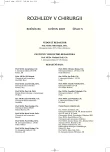Vertebral Body Replacement with a Synex Implant
Authors:
J. Zeman; J. Matějka; J. Belatka; J. Vodička
Authors‘ workplace:
Koudela, CSc.
; Chirurgická klinika LF UK a FN Plzeň, přednosta. prof. MUDr. L. Třeška, DrSc
; Klinika ortopedie a traumatologie pohybového ústrojí LF UK a FN Plzeň, přednosta: prof. MUDr. K.
Published in:
Rozhl. Chir., 2007, roč. 86, č. 5, s. 263-267.
Category:
Monothematic special - Original
Overview
Aim:
The authors assessed options for vertebral body replacements with the Synex telescopic expansion cage. Autologic or homologic bone grafts, a titanium “Harm’s“ cage or a polymethylmetacrylate filling reinforced by Kirschner wires , may be used for vertebral body replacements. The cement filling is indicated in oncological patients, the Harm’s cage requires filling with a quantity of bone grafts and, with massive bone grafts, the collection place or the graft availability may be a problem. The telescopic expansion implant is fairly easy to implant, is stable and requires to be filled with a minimum of spongious grafts.
Material:
From May 2001 to November 2005, 20 telescopic Synex cages were implanted in 18 patients. Vertebral body replacements were performed 14x for acute fractures, 4x for posttraumatic kyphosis and 2x for metastatic skeletal disorder in breast and prostate tumors.
Methods:
Vertebral body replacement was completed with posterior transpedicular stabilization in 14 subjects, in 5 subjects, additional anterior Ventrofix stabilization was performed. Vertebral body replacements down to the L1 level were conducted through thoracotomy or video-assissted minithoracotomy, L2-L4 replacements from lumbotomy or anterior retroperitoneal approach.
Results:
The most requently affected and operated vertebrae included the L1 (4 patients), Th12 (4 patients), Th6 (3 patients). The minimal interval between the procedure and a follow- up was 12 months. No fatal outcome has been recorded. In one patient with a vertebral body metastasis, the disorder has generalized and in a second one, no further metastatic spread has been reported. In one subject, the left-sided L4 root injury was recorded postoperatively, a cauda equina syndrome, diagnosed after the injury, persits in one subject. No signs of deep infection have been recorded. There are no records of the Synex release or displacement. Correction loss (kyphotisation) of up to 2 degrees was recorded in patients with transpedicular stabilization, in Ventrofix patients the loss was up to 5 degrees, except one case, where the loss reached 10 degrees.
Discussion:
One of the commonest indications for the anterior approach surgical stabilization of the spine, is the vertebral body destruction in burst fractures or posstraumatic kyphotizations of the spinal column. Unhealed or poorly healed type A and B (AO classification) pincer vertebral body fractures are other common indications for partial corpectomy and vertebral body replacements. Such fractures can be managed using posterior transpedicular stabilization. However, provided the procedure results in insufficient fracture repositioning, the anterior procedure and the anterior column reconstruction must be performed.
A vertebral body can be replaced by a bone graft, a cement filling with Kirschner wiring, a traditional Harm’s cage or an expansion implant. The bone graft may be autologic, which involves a disadvantage of the „donor site pain“, or homologic, although a potential for reconstruction is not fully evidenced here. Implant migration into the vertebral body has been recorded in the classical titanium Harm’s cage with a sharp edge without an additional endplate. Furthermore, it is a rather complicated implantation, requiring an exact implant size, which is considered another disadvantage. The expansion implant may be expanded telescopically in the very place, which is considered its biggest advantage. Furthermore, it need not be filled with bone grafts, but is applied only ventrally or laterally to the cage.
Conclusion:
The Synex titanium expansion implant has been designed for vertebral body implantations in any indication. It requires additional stabilization, either by an anterior fixator or a cast, or a posterior transpedicular fixation. It is primarily indicated in traumatic vertebral body destructions or in reconstructions of maltreated fractures. Considering its higher price and the expected shorter patient survival period in oncological patients, its use in oncological indications is controversial.
Key words:
Synex implant – vertebral body
Sources
1. Griss, P. Osteosynthesen und Wirbelkorperersatz bei Wirbelsaulentumoren. Orthopade, 1987, 16, 415–421.
2. Kim, D. H., Vaccaro, A. R., Fessler, R. G. Spinal Instrumentation Surgical Techniques. New York Thieme Medical Publisher 2005. ISBN 1-58890-375-3.
3. Harrington, K. D. The use of Methylmethacrylate for Vertebral-body Replacement and Anterior stablization of Pathological Fracture-dislocations of the Spine Due to Metastatic Malignant Disease. J. Bone Jt. Surg., 1981, 63-A: 36–46.
4. Magerl, F., Aebi, M., Gertzbein, S. D., Harms, J., Nazarian, S. A Comprehenshive Classification of thoracic and Lumbar Injuries. Europ. Spine J., 1994, 3, 184–201.
5. McCormack, T., Karaikovic, E., Gaines, R. The Low Sparing Classification of Spine Fractures. Spine, ,1994, 19, 1741–174.
6. Knop, C., Lange, U., Reinhold, M., Blauth, M. Vertebral body replacement with Synex in combined posteroanterior surgery for treatment of thoracolumbar injurie. Oper. Orthop. Traumatol., 2005,17(3): 249–280.
7. Krbec, M., Štulík, J., Tichý, V. Náhrada obratlového těla expanzním implantátem (Synex). Acta Chir. orthop. Trauma. čech., 2005, 69, 158–162.
8. Matějka, J. Hyperextensionsverletzungen der thorakolumbalen Wirbelsäule. Zentralblatt für Chirurgie, 2006, 131, 75–79.
9. Knop, C., Lange, U., Bastian, L., Blauth, M. Biomechanical stability with a new artificial vertebral body implant. 3-dimensional movement analysis of instrumented human vertebral segments. Unfallchirurg, 2001, 104(10), 984–997.
Labels
Surgery Orthopaedics Trauma surgeryArticle was published in
Perspectives in Surgery

2007 Issue 5
Most read in this issue
- Current Trends of the Treatment of the Femoral Neck Fractures in Seniors
- Application of the Targon PH Long Nail in Storey Fractures and Metaphyseal Fractures of the Proximal Humerus
- Vertebral Body Replacement with a Synex Implant
- Tactical and Technical Notes for Decompression Surgery – a Review
